Business Environment Report: NHS, ASOS, CafePod, and Amnesty Intl.
VerifiedAdded on 2023/06/07
|18
|5046
|253
Report
AI Summary
This report delves into the business environments of various organizations, including NHS, ASOS, CafePod, and Amnesty International, examining their structures, sizes, scopes, and objectives. The analysis encompasses public, private, and voluntary sectors, exploring the relationships between organizational functions like marketing and finance and how they link to organizational objectives and structures. The report utilizes strategic business analysis tools such as SWOT and PESTLE to compare companies and identify market challenges. The report further contrasts the business sectors, sizes, and structures of CafePod and Amnesty International, highlighting their differences and illustrating how organizational design influences operations and the achievement of goals. Finally, the report analyzes the interrelationships between organizational functions and their impact on organizational structure, with a focus on marketing and finance.
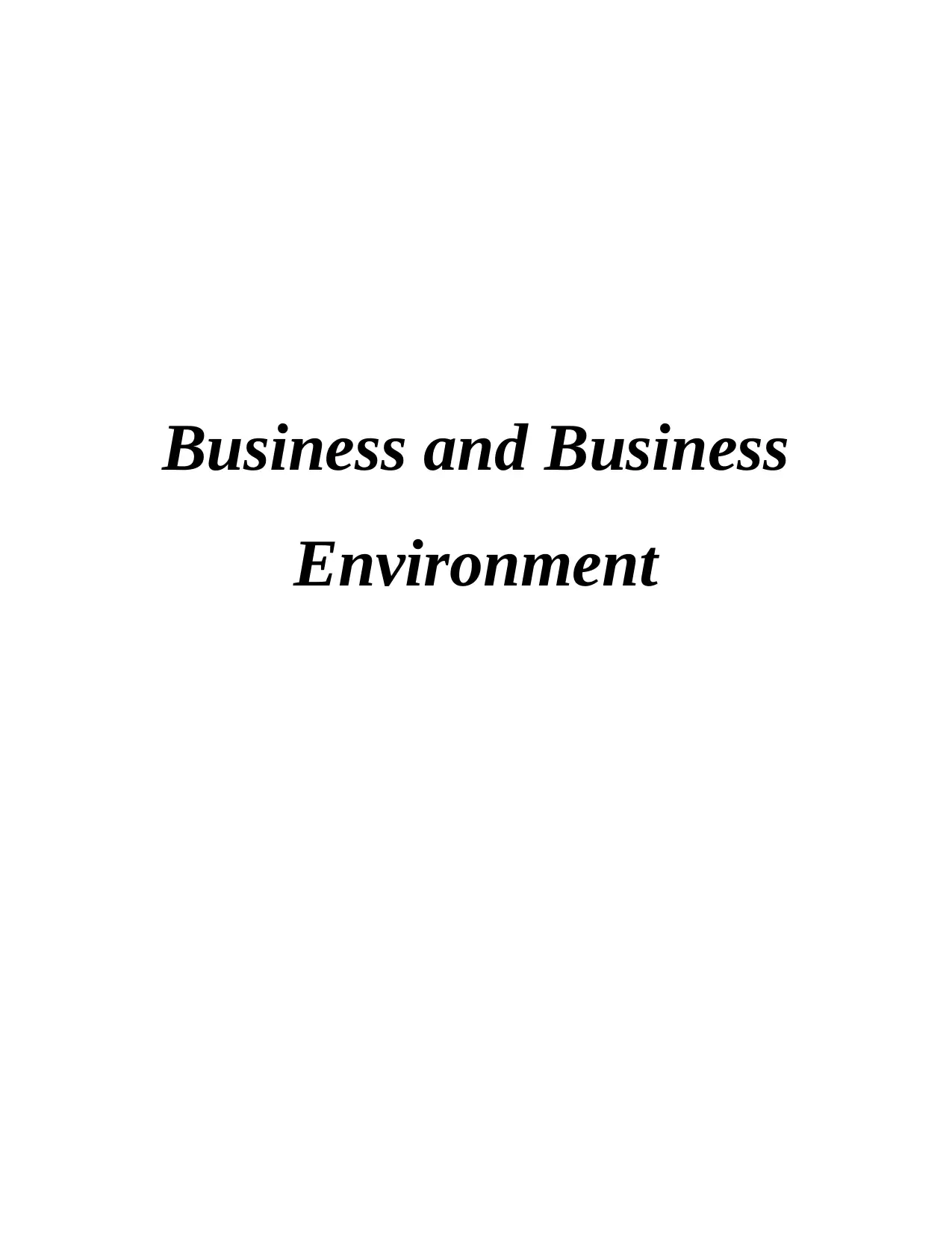
Business and Business
Environment
Environment
Paraphrase This Document
Need a fresh take? Get an instant paraphrase of this document with our AI Paraphraser
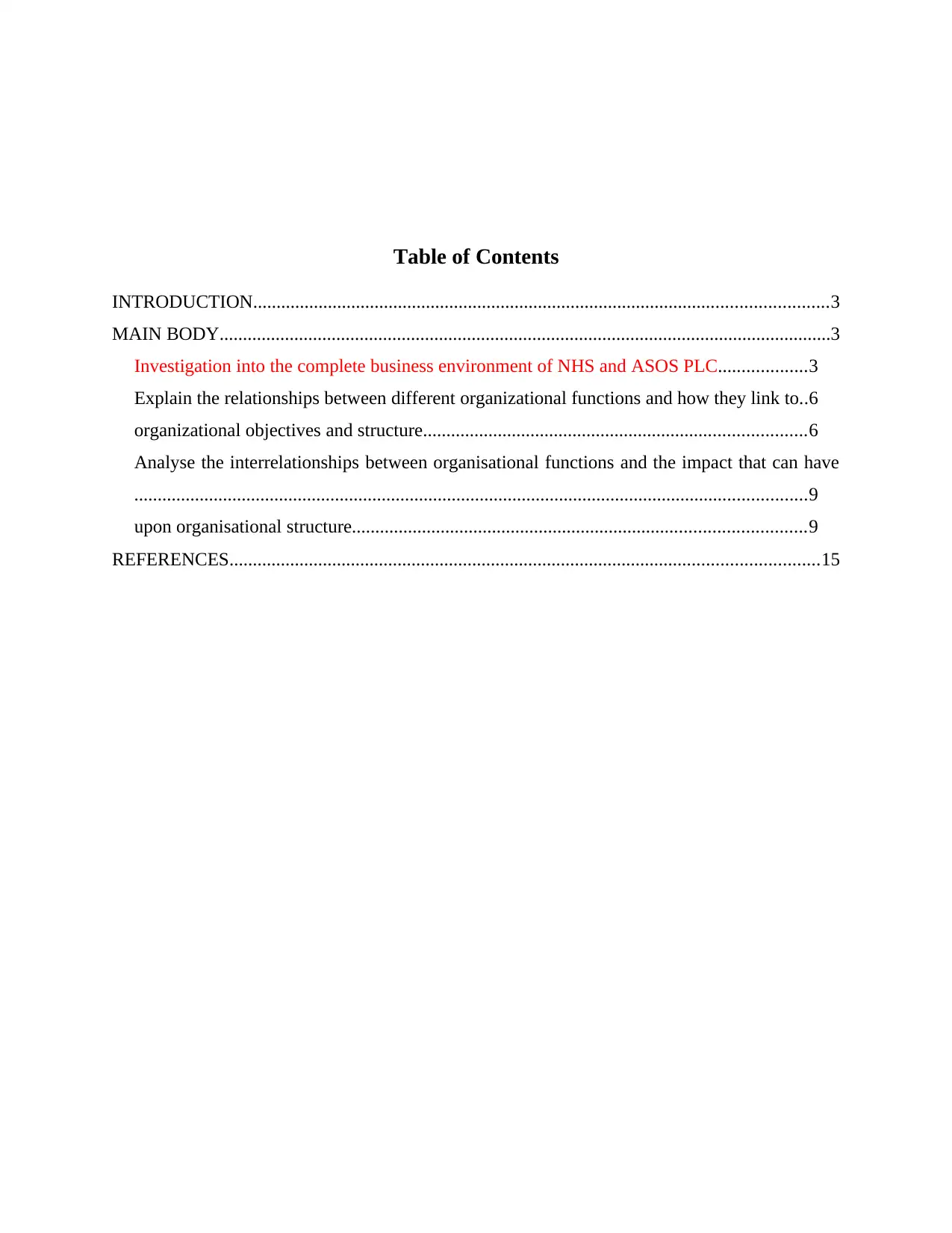
Table of Contents
INTRODUCTION...........................................................................................................................3
MAIN BODY...................................................................................................................................3
Investigation into the complete business environment of NHS and ASOS PLC...................3
Explain the relationships between different organizational functions and how they link to..6
organizational objectives and structure..................................................................................6
Analyse the interrelationships between organisational functions and the impact that can have
................................................................................................................................................9
upon organisational structure.................................................................................................9
REFERENCES..............................................................................................................................15
INTRODUCTION...........................................................................................................................3
MAIN BODY...................................................................................................................................3
Investigation into the complete business environment of NHS and ASOS PLC...................3
Explain the relationships between different organizational functions and how they link to..6
organizational objectives and structure..................................................................................6
Analyse the interrelationships between organisational functions and the impact that can have
................................................................................................................................................9
upon organisational structure.................................................................................................9
REFERENCES..............................................................................................................................15
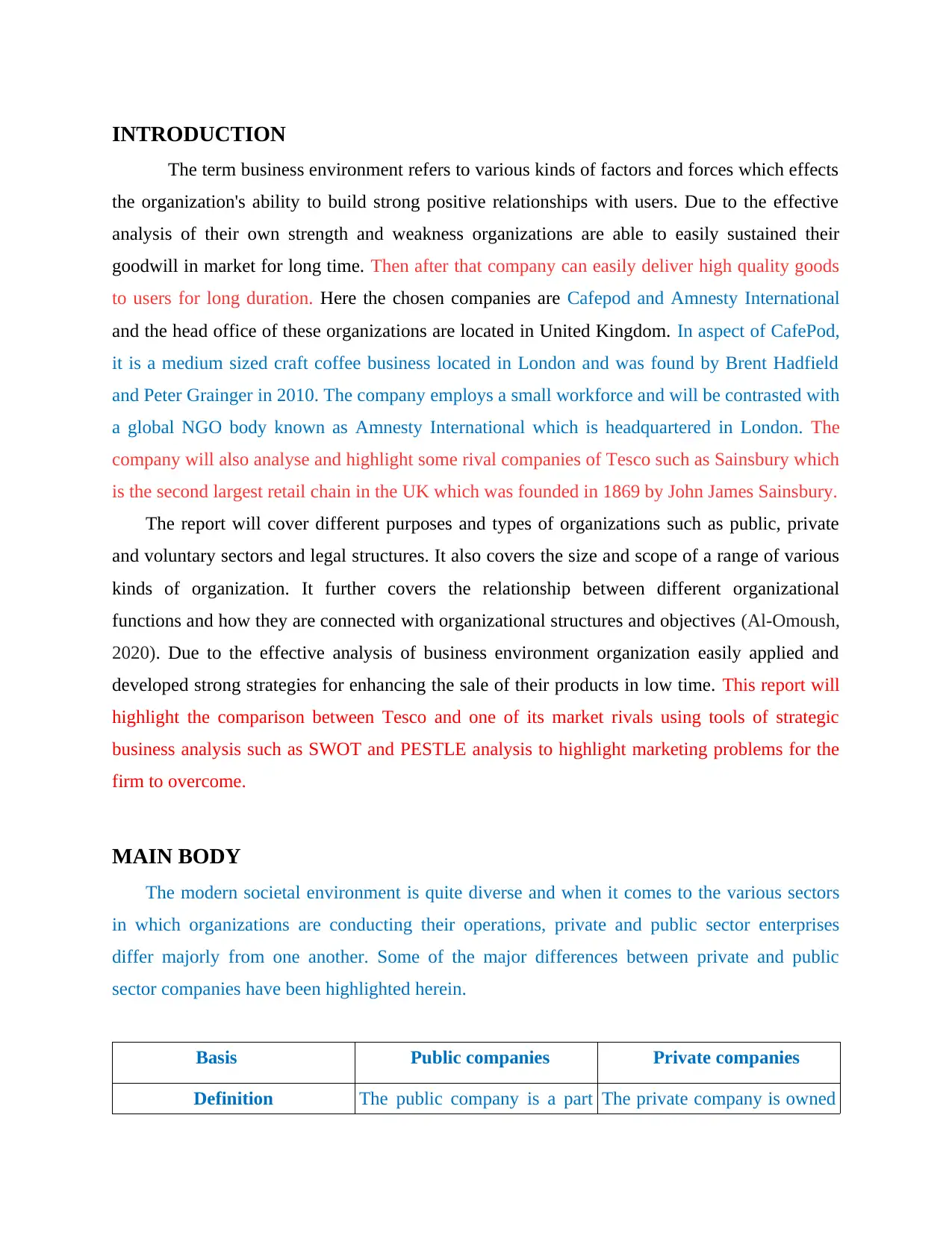
INTRODUCTION
The term business environment refers to various kinds of factors and forces which effects
the organization's ability to build strong positive relationships with users. Due to the effective
analysis of their own strength and weakness organizations are able to easily sustained their
goodwill in market for long time. Then after that company can easily deliver high quality goods
to users for long duration. Here the chosen companies are Cafepod and Amnesty International
and the head office of these organizations are located in United Kingdom. In aspect of CafePod,
it is a medium sized craft coffee business located in London and was found by Brent Hadfield
and Peter Grainger in 2010. The company employs a small workforce and will be contrasted with
a global NGO body known as Amnesty International which is headquartered in London. The
company will also analyse and highlight some rival companies of Tesco such as Sainsbury which
is the second largest retail chain in the UK which was founded in 1869 by John James Sainsbury.
The report will cover different purposes and types of organizations such as public, private
and voluntary sectors and legal structures. It also covers the size and scope of a range of various
kinds of organization. It further covers the relationship between different organizational
functions and how they are connected with organizational structures and objectives (Al-Omoush,
2020). Due to the effective analysis of business environment organization easily applied and
developed strong strategies for enhancing the sale of their products in low time. This report will
highlight the comparison between Tesco and one of its market rivals using tools of strategic
business analysis such as SWOT and PESTLE analysis to highlight marketing problems for the
firm to overcome.
MAIN BODY
The modern societal environment is quite diverse and when it comes to the various sectors
in which organizations are conducting their operations, private and public sector enterprises
differ majorly from one another. Some of the major differences between private and public
sector companies have been highlighted herein.
Basis Public companies Private companies
Definition The public company is a part The private company is owned
The term business environment refers to various kinds of factors and forces which effects
the organization's ability to build strong positive relationships with users. Due to the effective
analysis of their own strength and weakness organizations are able to easily sustained their
goodwill in market for long time. Then after that company can easily deliver high quality goods
to users for long duration. Here the chosen companies are Cafepod and Amnesty International
and the head office of these organizations are located in United Kingdom. In aspect of CafePod,
it is a medium sized craft coffee business located in London and was found by Brent Hadfield
and Peter Grainger in 2010. The company employs a small workforce and will be contrasted with
a global NGO body known as Amnesty International which is headquartered in London. The
company will also analyse and highlight some rival companies of Tesco such as Sainsbury which
is the second largest retail chain in the UK which was founded in 1869 by John James Sainsbury.
The report will cover different purposes and types of organizations such as public, private
and voluntary sectors and legal structures. It also covers the size and scope of a range of various
kinds of organization. It further covers the relationship between different organizational
functions and how they are connected with organizational structures and objectives (Al-Omoush,
2020). Due to the effective analysis of business environment organization easily applied and
developed strong strategies for enhancing the sale of their products in low time. This report will
highlight the comparison between Tesco and one of its market rivals using tools of strategic
business analysis such as SWOT and PESTLE analysis to highlight marketing problems for the
firm to overcome.
MAIN BODY
The modern societal environment is quite diverse and when it comes to the various sectors
in which organizations are conducting their operations, private and public sector enterprises
differ majorly from one another. Some of the major differences between private and public
sector companies have been highlighted herein.
Basis Public companies Private companies
Definition The public company is a part The private company is owned
⊘ This is a preview!⊘
Do you want full access?
Subscribe today to unlock all pages.

Trusted by 1+ million students worldwide
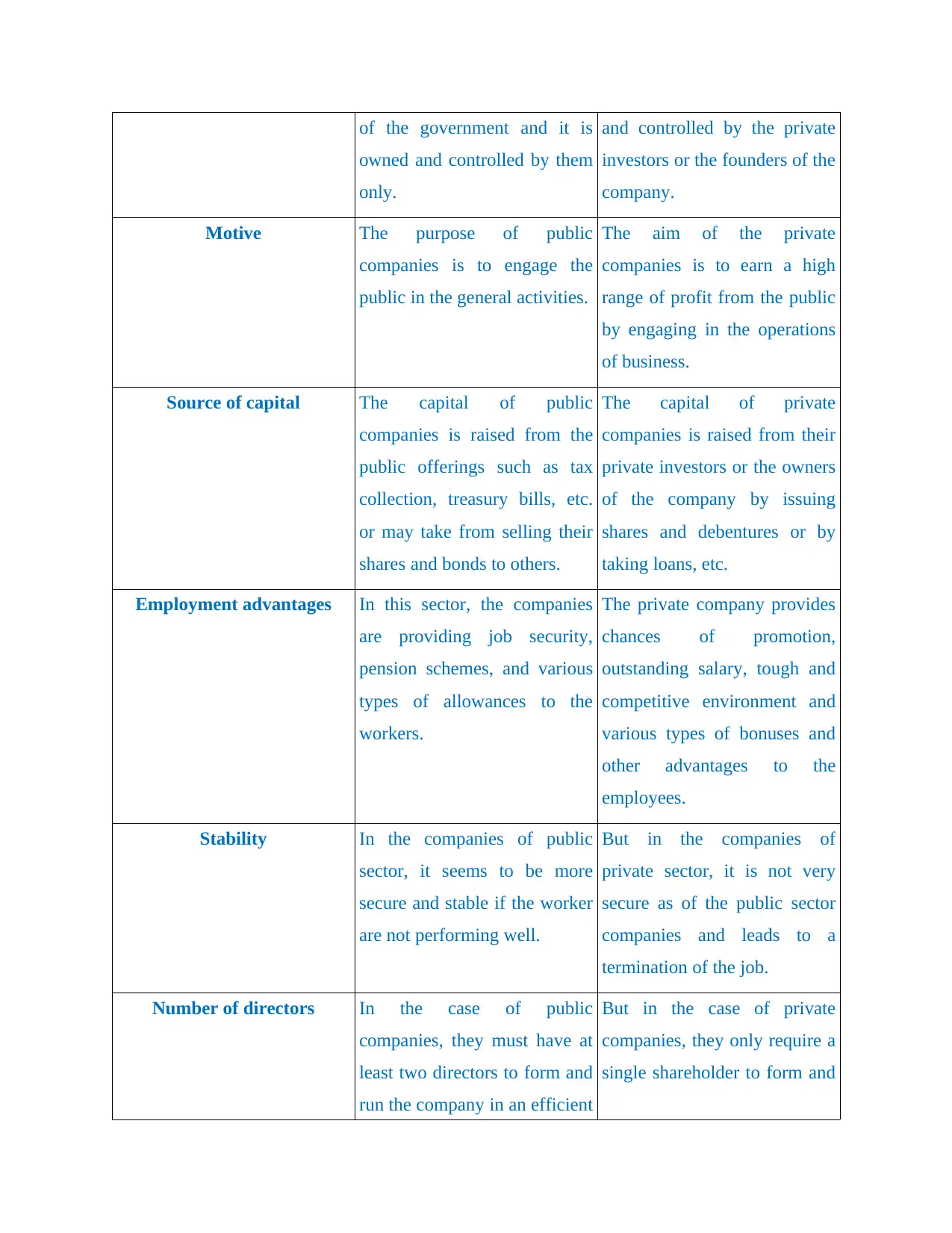
of the government and it is
owned and controlled by them
only.
and controlled by the private
investors or the founders of the
company.
Motive The purpose of public
companies is to engage the
public in the general activities.
The aim of the private
companies is to earn a high
range of profit from the public
by engaging in the operations
of business.
Source of capital The capital of public
companies is raised from the
public offerings such as tax
collection, treasury bills, etc.
or may take from selling their
shares and bonds to others.
The capital of private
companies is raised from their
private investors or the owners
of the company by issuing
shares and debentures or by
taking loans, etc.
Employment advantages In this sector, the companies
are providing job security,
pension schemes, and various
types of allowances to the
workers.
The private company provides
chances of promotion,
outstanding salary, tough and
competitive environment and
various types of bonuses and
other advantages to the
employees.
Stability In the companies of public
sector, it seems to be more
secure and stable if the worker
are not performing well.
But in the companies of
private sector, it is not very
secure as of the public sector
companies and leads to a
termination of the job.
Number of directors In the case of public
companies, they must have at
least two directors to form and
run the company in an efficient
But in the case of private
companies, they only require a
single shareholder to form and
owned and controlled by them
only.
and controlled by the private
investors or the founders of the
company.
Motive The purpose of public
companies is to engage the
public in the general activities.
The aim of the private
companies is to earn a high
range of profit from the public
by engaging in the operations
of business.
Source of capital The capital of public
companies is raised from the
public offerings such as tax
collection, treasury bills, etc.
or may take from selling their
shares and bonds to others.
The capital of private
companies is raised from their
private investors or the owners
of the company by issuing
shares and debentures or by
taking loans, etc.
Employment advantages In this sector, the companies
are providing job security,
pension schemes, and various
types of allowances to the
workers.
The private company provides
chances of promotion,
outstanding salary, tough and
competitive environment and
various types of bonuses and
other advantages to the
employees.
Stability In the companies of public
sector, it seems to be more
secure and stable if the worker
are not performing well.
But in the companies of
private sector, it is not very
secure as of the public sector
companies and leads to a
termination of the job.
Number of directors In the case of public
companies, they must have at
least two directors to form and
run the company in an efficient
But in the case of private
companies, they only require a
single shareholder to form and
Paraphrase This Document
Need a fresh take? Get an instant paraphrase of this document with our AI Paraphraser
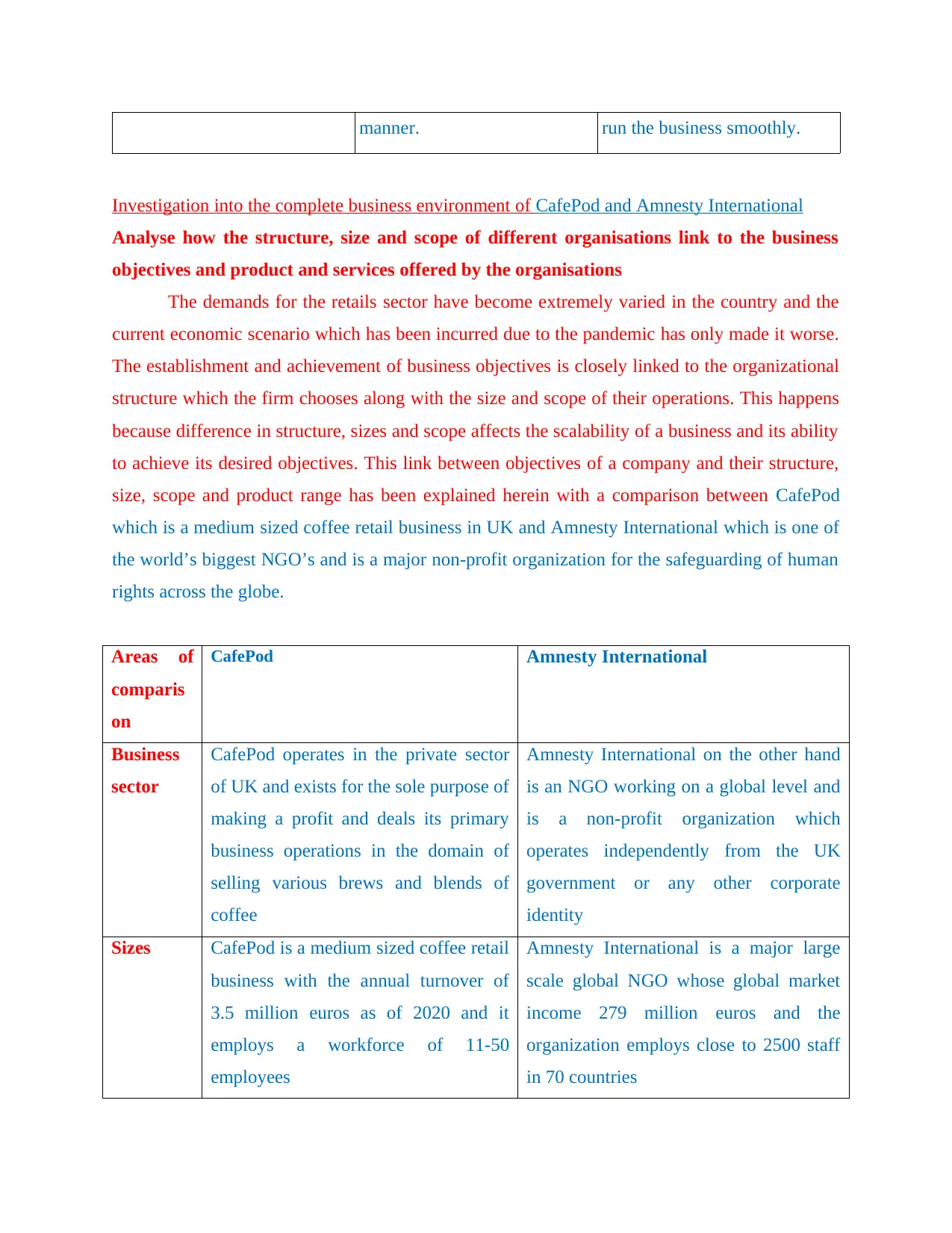
manner. run the business smoothly.
Investigation into the complete business environment of CafePod and Amnesty International
Analyse how the structure, size and scope of different organisations link to the business
objectives and product and services offered by the organisations
The demands for the retails sector have become extremely varied in the country and the
current economic scenario which has been incurred due to the pandemic has only made it worse.
The establishment and achievement of business objectives is closely linked to the organizational
structure which the firm chooses along with the size and scope of their operations. This happens
because difference in structure, sizes and scope affects the scalability of a business and its ability
to achieve its desired objectives. This link between objectives of a company and their structure,
size, scope and product range has been explained herein with a comparison between CafePod
which is a medium sized coffee retail business in UK and Amnesty International which is one of
the world’s biggest NGO’s and is a major non-profit organization for the safeguarding of human
rights across the globe.
Areas of
comparis
on
CafePod Amnesty International
Business
sector
CafePod operates in the private sector
of UK and exists for the sole purpose of
making a profit and deals its primary
business operations in the domain of
selling various brews and blends of
coffee
Amnesty International on the other hand
is an NGO working on a global level and
is a non-profit organization which
operates independently from the UK
government or any other corporate
identity
Sizes CafePod is a medium sized coffee retail
business with the annual turnover of
3.5 million euros as of 2020 and it
employs a workforce of 11-50
employees
Amnesty International is a major large
scale global NGO whose global market
income 279 million euros and the
organization employs close to 2500 staff
in 70 countries
Investigation into the complete business environment of CafePod and Amnesty International
Analyse how the structure, size and scope of different organisations link to the business
objectives and product and services offered by the organisations
The demands for the retails sector have become extremely varied in the country and the
current economic scenario which has been incurred due to the pandemic has only made it worse.
The establishment and achievement of business objectives is closely linked to the organizational
structure which the firm chooses along with the size and scope of their operations. This happens
because difference in structure, sizes and scope affects the scalability of a business and its ability
to achieve its desired objectives. This link between objectives of a company and their structure,
size, scope and product range has been explained herein with a comparison between CafePod
which is a medium sized coffee retail business in UK and Amnesty International which is one of
the world’s biggest NGO’s and is a major non-profit organization for the safeguarding of human
rights across the globe.
Areas of
comparis
on
CafePod Amnesty International
Business
sector
CafePod operates in the private sector
of UK and exists for the sole purpose of
making a profit and deals its primary
business operations in the domain of
selling various brews and blends of
coffee
Amnesty International on the other hand
is an NGO working on a global level and
is a non-profit organization which
operates independently from the UK
government or any other corporate
identity
Sizes CafePod is a medium sized coffee retail
business with the annual turnover of
3.5 million euros as of 2020 and it
employs a workforce of 11-50
employees
Amnesty International is a major large
scale global NGO whose global market
income 279 million euros and the
organization employs close to 2500 staff
in 70 countries
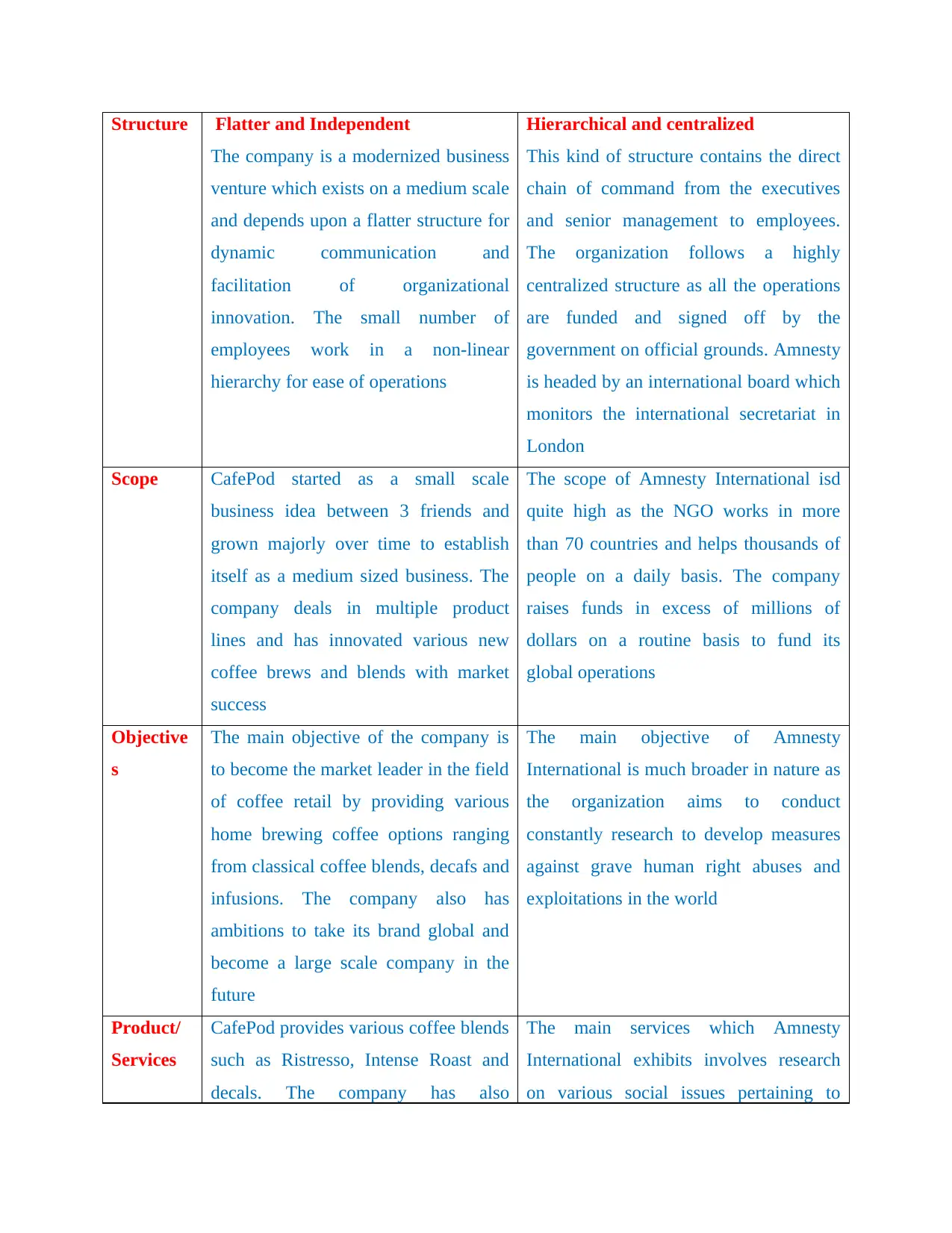
Structure Flatter and Independent
The company is a modernized business
venture which exists on a medium scale
and depends upon a flatter structure for
dynamic communication and
facilitation of organizational
innovation. The small number of
employees work in a non-linear
hierarchy for ease of operations
Hierarchical and centralized
This kind of structure contains the direct
chain of command from the executives
and senior management to employees.
The organization follows a highly
centralized structure as all the operations
are funded and signed off by the
government on official grounds. Amnesty
is headed by an international board which
monitors the international secretariat in
London
Scope CafePod started as a small scale
business idea between 3 friends and
grown majorly over time to establish
itself as a medium sized business. The
company deals in multiple product
lines and has innovated various new
coffee brews and blends with market
success
The scope of Amnesty International isd
quite high as the NGO works in more
than 70 countries and helps thousands of
people on a daily basis. The company
raises funds in excess of millions of
dollars on a routine basis to fund its
global operations
Objective
s
The main objective of the company is
to become the market leader in the field
of coffee retail by providing various
home brewing coffee options ranging
from classical coffee blends, decafs and
infusions. The company also has
ambitions to take its brand global and
become a large scale company in the
future
The main objective of Amnesty
International is much broader in nature as
the organization aims to conduct
constantly research to develop measures
against grave human right abuses and
exploitations in the world
Product/
Services
CafePod provides various coffee blends
such as Ristresso, Intense Roast and
decals. The company has also
The main services which Amnesty
International exhibits involves research
on various social issues pertaining to
The company is a modernized business
venture which exists on a medium scale
and depends upon a flatter structure for
dynamic communication and
facilitation of organizational
innovation. The small number of
employees work in a non-linear
hierarchy for ease of operations
Hierarchical and centralized
This kind of structure contains the direct
chain of command from the executives
and senior management to employees.
The organization follows a highly
centralized structure as all the operations
are funded and signed off by the
government on official grounds. Amnesty
is headed by an international board which
monitors the international secretariat in
London
Scope CafePod started as a small scale
business idea between 3 friends and
grown majorly over time to establish
itself as a medium sized business. The
company deals in multiple product
lines and has innovated various new
coffee brews and blends with market
success
The scope of Amnesty International isd
quite high as the NGO works in more
than 70 countries and helps thousands of
people on a daily basis. The company
raises funds in excess of millions of
dollars on a routine basis to fund its
global operations
Objective
s
The main objective of the company is
to become the market leader in the field
of coffee retail by providing various
home brewing coffee options ranging
from classical coffee blends, decafs and
infusions. The company also has
ambitions to take its brand global and
become a large scale company in the
future
The main objective of Amnesty
International is much broader in nature as
the organization aims to conduct
constantly research to develop measures
against grave human right abuses and
exploitations in the world
Product/
Services
CafePod provides various coffee blends
such as Ristresso, Intense Roast and
decals. The company has also
The main services which Amnesty
International exhibits involves research
on various social issues pertaining to
⊘ This is a preview!⊘
Do you want full access?
Subscribe today to unlock all pages.

Trusted by 1+ million students worldwide
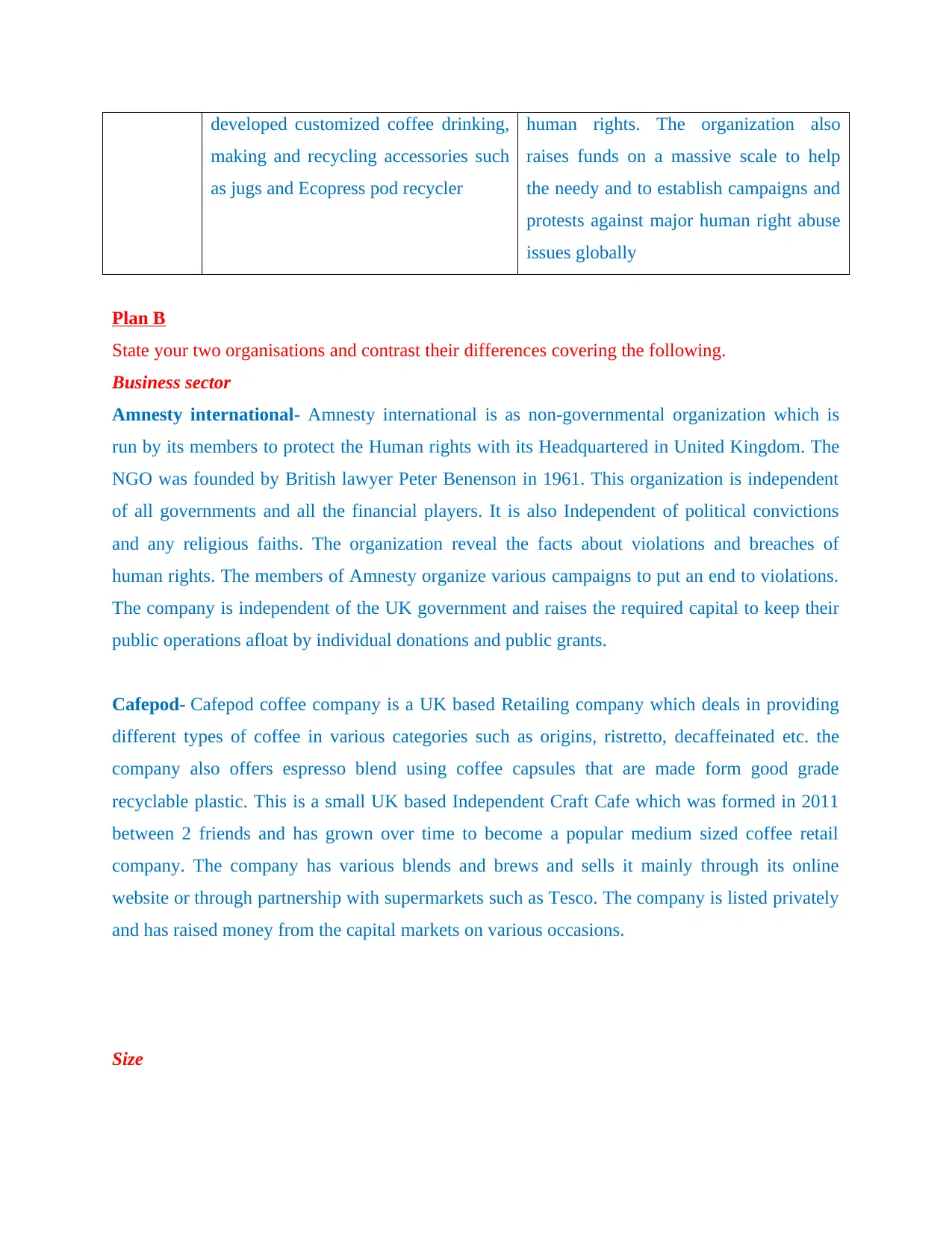
developed customized coffee drinking,
making and recycling accessories such
as jugs and Ecopress pod recycler
human rights. The organization also
raises funds on a massive scale to help
the needy and to establish campaigns and
protests against major human right abuse
issues globally
Plan B
State your two organisations and contrast their differences covering the following.
Business sector
Amnesty international- Amnesty international is as non-governmental organization which is
run by its members to protect the Human rights with its Headquartered in United Kingdom. The
NGO was founded by British lawyer Peter Benenson in 1961. This organization is independent
of all governments and all the financial players. It is also Independent of political convictions
and any religious faiths. The organization reveal the facts about violations and breaches of
human rights. The members of Amnesty organize various campaigns to put an end to violations.
The company is independent of the UK government and raises the required capital to keep their
public operations afloat by individual donations and public grants.
Cafepod- Cafepod coffee company is a UK based Retailing company which deals in providing
different types of coffee in various categories such as origins, ristretto, decaffeinated etc. the
company also offers espresso blend using coffee capsules that are made form good grade
recyclable plastic. This is a small UK based Independent Craft Cafe which was formed in 2011
between 2 friends and has grown over time to become a popular medium sized coffee retail
company. The company has various blends and brews and sells it mainly through its online
website or through partnership with supermarkets such as Tesco. The company is listed privately
and has raised money from the capital markets on various occasions.
Size
making and recycling accessories such
as jugs and Ecopress pod recycler
human rights. The organization also
raises funds on a massive scale to help
the needy and to establish campaigns and
protests against major human right abuse
issues globally
Plan B
State your two organisations and contrast their differences covering the following.
Business sector
Amnesty international- Amnesty international is as non-governmental organization which is
run by its members to protect the Human rights with its Headquartered in United Kingdom. The
NGO was founded by British lawyer Peter Benenson in 1961. This organization is independent
of all governments and all the financial players. It is also Independent of political convictions
and any religious faiths. The organization reveal the facts about violations and breaches of
human rights. The members of Amnesty organize various campaigns to put an end to violations.
The company is independent of the UK government and raises the required capital to keep their
public operations afloat by individual donations and public grants.
Cafepod- Cafepod coffee company is a UK based Retailing company which deals in providing
different types of coffee in various categories such as origins, ristretto, decaffeinated etc. the
company also offers espresso blend using coffee capsules that are made form good grade
recyclable plastic. This is a small UK based Independent Craft Cafe which was formed in 2011
between 2 friends and has grown over time to become a popular medium sized coffee retail
company. The company has various blends and brews and sells it mainly through its online
website or through partnership with supermarkets such as Tesco. The company is listed privately
and has raised money from the capital markets on various occasions.
Size
Paraphrase This Document
Need a fresh take? Get an instant paraphrase of this document with our AI Paraphraser
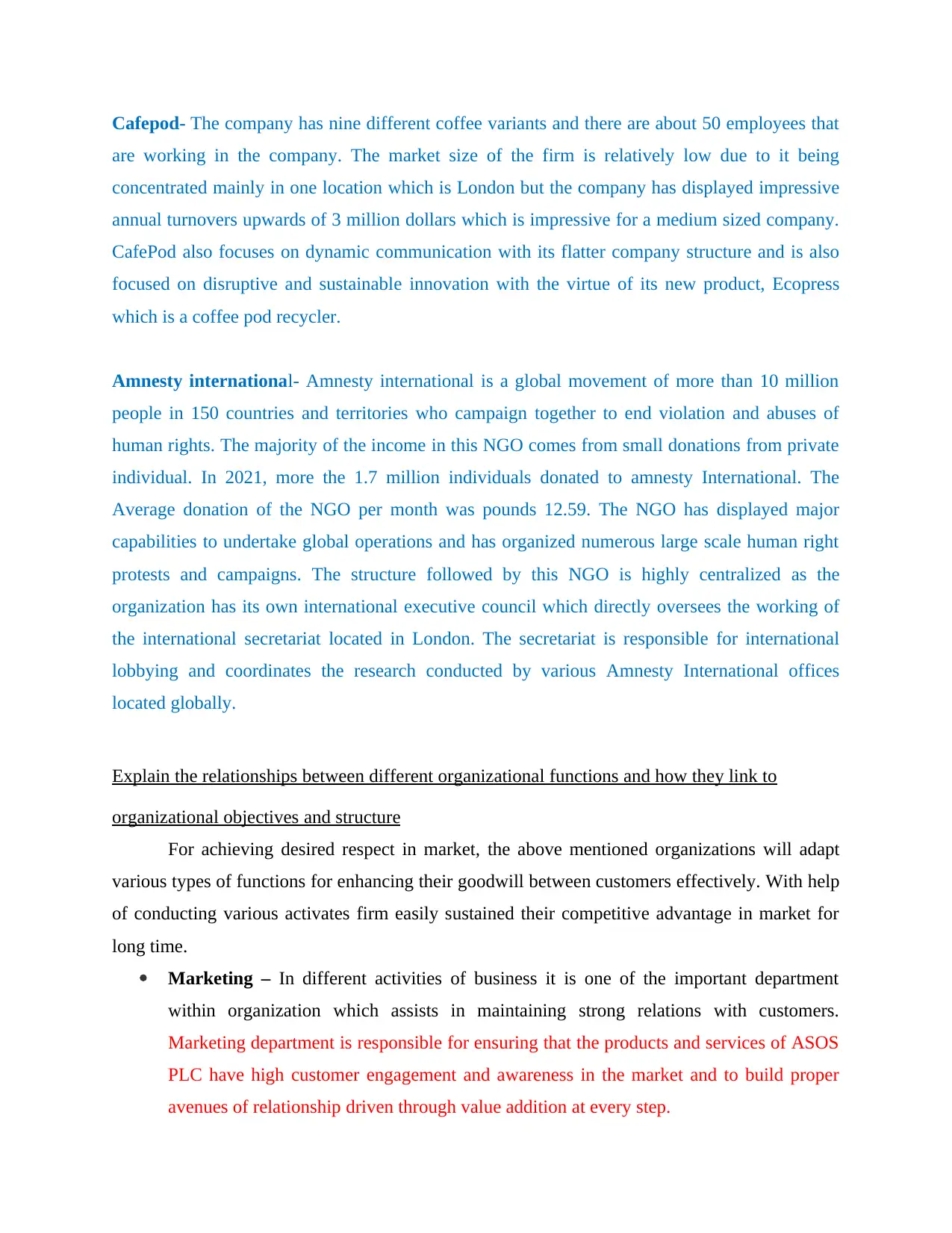
Cafepod- The company has nine different coffee variants and there are about 50 employees that
are working in the company. The market size of the firm is relatively low due to it being
concentrated mainly in one location which is London but the company has displayed impressive
annual turnovers upwards of 3 million dollars which is impressive for a medium sized company.
CafePod also focuses on dynamic communication with its flatter company structure and is also
focused on disruptive and sustainable innovation with the virtue of its new product, Ecopress
which is a coffee pod recycler.
Amnesty international- Amnesty international is a global movement of more than 10 million
people in 150 countries and territories who campaign together to end violation and abuses of
human rights. The majority of the income in this NGO comes from small donations from private
individual. In 2021, more the 1.7 million individuals donated to amnesty International. The
Average donation of the NGO per month was pounds 12.59. The NGO has displayed major
capabilities to undertake global operations and has organized numerous large scale human right
protests and campaigns. The structure followed by this NGO is highly centralized as the
organization has its own international executive council which directly oversees the working of
the international secretariat located in London. The secretariat is responsible for international
lobbying and coordinates the research conducted by various Amnesty International offices
located globally.
Explain the relationships between different organizational functions and how they link to
organizational objectives and structure
For achieving desired respect in market, the above mentioned organizations will adapt
various types of functions for enhancing their goodwill between customers effectively. With help
of conducting various activates firm easily sustained their competitive advantage in market for
long time.
Marketing – In different activities of business it is one of the important department
within organization which assists in maintaining strong relations with customers.
Marketing department is responsible for ensuring that the products and services of ASOS
PLC have high customer engagement and awareness in the market and to build proper
avenues of relationship driven through value addition at every step.
are working in the company. The market size of the firm is relatively low due to it being
concentrated mainly in one location which is London but the company has displayed impressive
annual turnovers upwards of 3 million dollars which is impressive for a medium sized company.
CafePod also focuses on dynamic communication with its flatter company structure and is also
focused on disruptive and sustainable innovation with the virtue of its new product, Ecopress
which is a coffee pod recycler.
Amnesty international- Amnesty international is a global movement of more than 10 million
people in 150 countries and territories who campaign together to end violation and abuses of
human rights. The majority of the income in this NGO comes from small donations from private
individual. In 2021, more the 1.7 million individuals donated to amnesty International. The
Average donation of the NGO per month was pounds 12.59. The NGO has displayed major
capabilities to undertake global operations and has organized numerous large scale human right
protests and campaigns. The structure followed by this NGO is highly centralized as the
organization has its own international executive council which directly oversees the working of
the international secretariat located in London. The secretariat is responsible for international
lobbying and coordinates the research conducted by various Amnesty International offices
located globally.
Explain the relationships between different organizational functions and how they link to
organizational objectives and structure
For achieving desired respect in market, the above mentioned organizations will adapt
various types of functions for enhancing their goodwill between customers effectively. With help
of conducting various activates firm easily sustained their competitive advantage in market for
long time.
Marketing – In different activities of business it is one of the important department
within organization which assists in maintaining strong relations with customers.
Marketing department is responsible for ensuring that the products and services of ASOS
PLC have high customer engagement and awareness in the market and to build proper
avenues of relationship driven through value addition at every step.
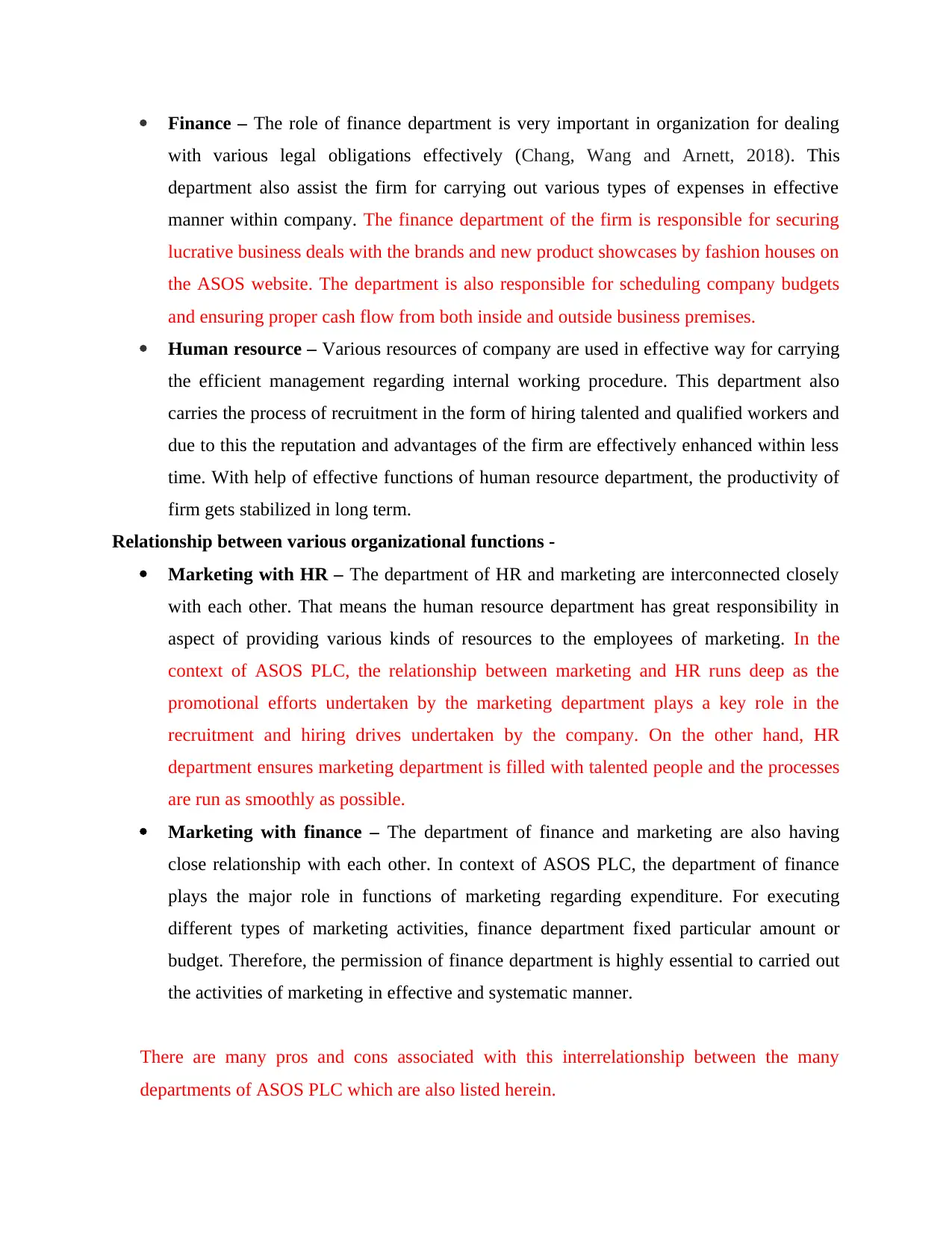
Finance – The role of finance department is very important in organization for dealing
with various legal obligations effectively (Chang, Wang and Arnett, 2018). This
department also assist the firm for carrying out various types of expenses in effective
manner within company. The finance department of the firm is responsible for securing
lucrative business deals with the brands and new product showcases by fashion houses on
the ASOS website. The department is also responsible for scheduling company budgets
and ensuring proper cash flow from both inside and outside business premises.
Human resource – Various resources of company are used in effective way for carrying
the efficient management regarding internal working procedure. This department also
carries the process of recruitment in the form of hiring talented and qualified workers and
due to this the reputation and advantages of the firm are effectively enhanced within less
time. With help of effective functions of human resource department, the productivity of
firm gets stabilized in long term.
Relationship between various organizational functions -
Marketing with HR – The department of HR and marketing are interconnected closely
with each other. That means the human resource department has great responsibility in
aspect of providing various kinds of resources to the employees of marketing. In the
context of ASOS PLC, the relationship between marketing and HR runs deep as the
promotional efforts undertaken by the marketing department plays a key role in the
recruitment and hiring drives undertaken by the company. On the other hand, HR
department ensures marketing department is filled with talented people and the processes
are run as smoothly as possible.
Marketing with finance – The department of finance and marketing are also having
close relationship with each other. In context of ASOS PLC, the department of finance
plays the major role in functions of marketing regarding expenditure. For executing
different types of marketing activities, finance department fixed particular amount or
budget. Therefore, the permission of finance department is highly essential to carried out
the activities of marketing in effective and systematic manner.
There are many pros and cons associated with this interrelationship between the many
departments of ASOS PLC which are also listed herein.
with various legal obligations effectively (Chang, Wang and Arnett, 2018). This
department also assist the firm for carrying out various types of expenses in effective
manner within company. The finance department of the firm is responsible for securing
lucrative business deals with the brands and new product showcases by fashion houses on
the ASOS website. The department is also responsible for scheduling company budgets
and ensuring proper cash flow from both inside and outside business premises.
Human resource – Various resources of company are used in effective way for carrying
the efficient management regarding internal working procedure. This department also
carries the process of recruitment in the form of hiring talented and qualified workers and
due to this the reputation and advantages of the firm are effectively enhanced within less
time. With help of effective functions of human resource department, the productivity of
firm gets stabilized in long term.
Relationship between various organizational functions -
Marketing with HR – The department of HR and marketing are interconnected closely
with each other. That means the human resource department has great responsibility in
aspect of providing various kinds of resources to the employees of marketing. In the
context of ASOS PLC, the relationship between marketing and HR runs deep as the
promotional efforts undertaken by the marketing department plays a key role in the
recruitment and hiring drives undertaken by the company. On the other hand, HR
department ensures marketing department is filled with talented people and the processes
are run as smoothly as possible.
Marketing with finance – The department of finance and marketing are also having
close relationship with each other. In context of ASOS PLC, the department of finance
plays the major role in functions of marketing regarding expenditure. For executing
different types of marketing activities, finance department fixed particular amount or
budget. Therefore, the permission of finance department is highly essential to carried out
the activities of marketing in effective and systematic manner.
There are many pros and cons associated with this interrelationship between the many
departments of ASOS PLC which are also listed herein.
⊘ This is a preview!⊘
Do you want full access?
Subscribe today to unlock all pages.

Trusted by 1+ million students worldwide
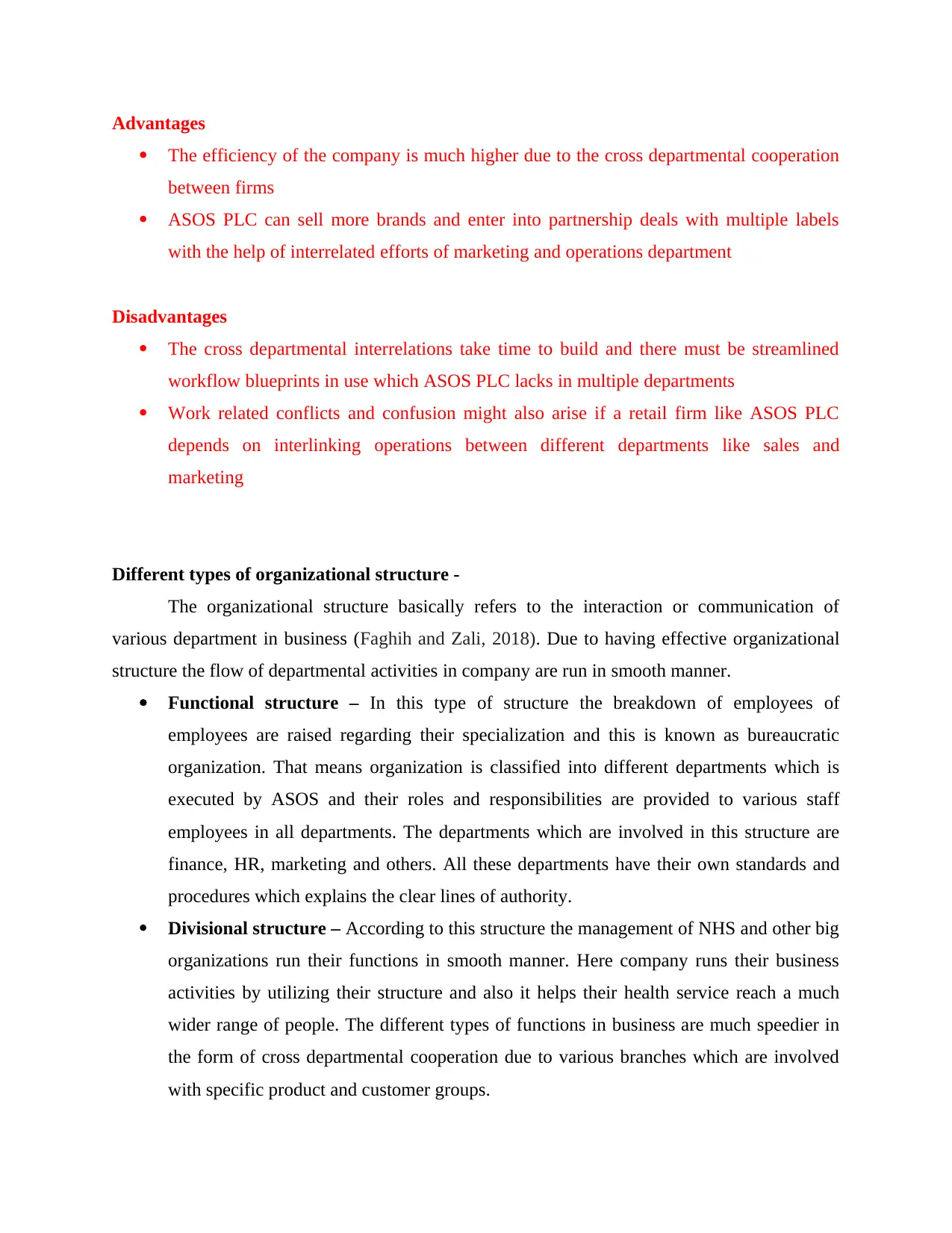
Advantages
The efficiency of the company is much higher due to the cross departmental cooperation
between firms
ASOS PLC can sell more brands and enter into partnership deals with multiple labels
with the help of interrelated efforts of marketing and operations department
Disadvantages
The cross departmental interrelations take time to build and there must be streamlined
workflow blueprints in use which ASOS PLC lacks in multiple departments
Work related conflicts and confusion might also arise if a retail firm like ASOS PLC
depends on interlinking operations between different departments like sales and
marketing
Different types of organizational structure -
The organizational structure basically refers to the interaction or communication of
various department in business (Faghih and Zali, 2018). Due to having effective organizational
structure the flow of departmental activities in company are run in smooth manner.
Functional structure – In this type of structure the breakdown of employees of
employees are raised regarding their specialization and this is known as bureaucratic
organization. That means organization is classified into different departments which is
executed by ASOS and their roles and responsibilities are provided to various staff
employees in all departments. The departments which are involved in this structure are
finance, HR, marketing and others. All these departments have their own standards and
procedures which explains the clear lines of authority.
Divisional structure – According to this structure the management of NHS and other big
organizations run their functions in smooth manner. Here company runs their business
activities by utilizing their structure and also it helps their health service reach a much
wider range of people. The different types of functions in business are much speedier in
the form of cross departmental cooperation due to various branches which are involved
with specific product and customer groups.
The efficiency of the company is much higher due to the cross departmental cooperation
between firms
ASOS PLC can sell more brands and enter into partnership deals with multiple labels
with the help of interrelated efforts of marketing and operations department
Disadvantages
The cross departmental interrelations take time to build and there must be streamlined
workflow blueprints in use which ASOS PLC lacks in multiple departments
Work related conflicts and confusion might also arise if a retail firm like ASOS PLC
depends on interlinking operations between different departments like sales and
marketing
Different types of organizational structure -
The organizational structure basically refers to the interaction or communication of
various department in business (Faghih and Zali, 2018). Due to having effective organizational
structure the flow of departmental activities in company are run in smooth manner.
Functional structure – In this type of structure the breakdown of employees of
employees are raised regarding their specialization and this is known as bureaucratic
organization. That means organization is classified into different departments which is
executed by ASOS and their roles and responsibilities are provided to various staff
employees in all departments. The departments which are involved in this structure are
finance, HR, marketing and others. All these departments have their own standards and
procedures which explains the clear lines of authority.
Divisional structure – According to this structure the management of NHS and other big
organizations run their functions in smooth manner. Here company runs their business
activities by utilizing their structure and also it helps their health service reach a much
wider range of people. The different types of functions in business are much speedier in
the form of cross departmental cooperation due to various branches which are involved
with specific product and customer groups.
Paraphrase This Document
Need a fresh take? Get an instant paraphrase of this document with our AI Paraphraser
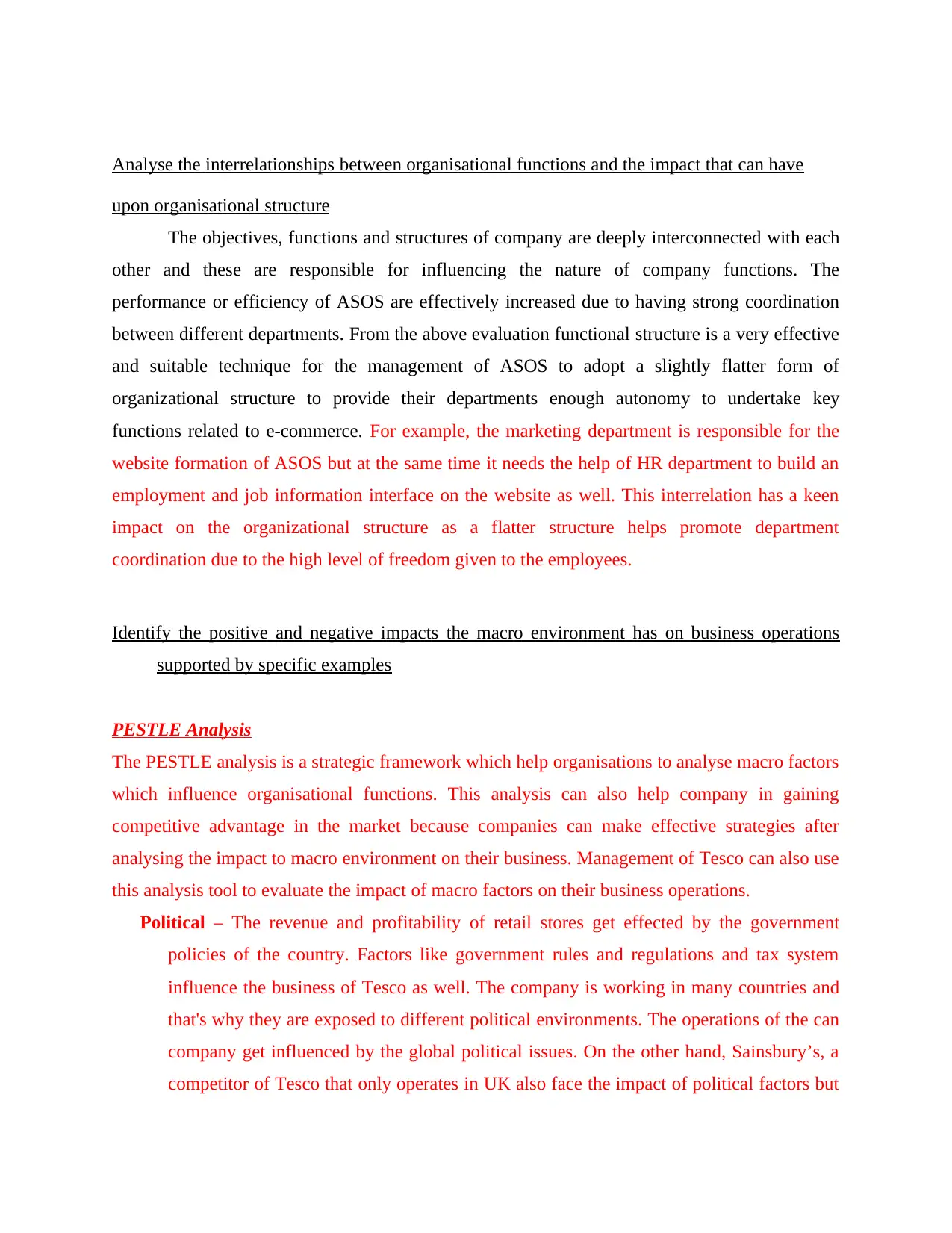
Analyse the interrelationships between organisational functions and the impact that can have
upon organisational structure
The objectives, functions and structures of company are deeply interconnected with each
other and these are responsible for influencing the nature of company functions. The
performance or efficiency of ASOS are effectively increased due to having strong coordination
between different departments. From the above evaluation functional structure is a very effective
and suitable technique for the management of ASOS to adopt a slightly flatter form of
organizational structure to provide their departments enough autonomy to undertake key
functions related to e-commerce. For example, the marketing department is responsible for the
website formation of ASOS but at the same time it needs the help of HR department to build an
employment and job information interface on the website as well. This interrelation has a keen
impact on the organizational structure as a flatter structure helps promote department
coordination due to the high level of freedom given to the employees.
Identify the positive and negative impacts the macro environment has on business operations
supported by specific examples
PESTLE Analysis
The PESTLE analysis is a strategic framework which help organisations to analyse macro factors
which influence organisational functions. This analysis can also help company in gaining
competitive advantage in the market because companies can make effective strategies after
analysing the impact to macro environment on their business. Management of Tesco can also use
this analysis tool to evaluate the impact of macro factors on their business operations.
Political – The revenue and profitability of retail stores get effected by the government
policies of the country. Factors like government rules and regulations and tax system
influence the business of Tesco as well. The company is working in many countries and
that's why they are exposed to different political environments. The operations of the can
company get influenced by the global political issues. On the other hand, Sainsbury’s, a
competitor of Tesco that only operates in UK also face the impact of political factors but
upon organisational structure
The objectives, functions and structures of company are deeply interconnected with each
other and these are responsible for influencing the nature of company functions. The
performance or efficiency of ASOS are effectively increased due to having strong coordination
between different departments. From the above evaluation functional structure is a very effective
and suitable technique for the management of ASOS to adopt a slightly flatter form of
organizational structure to provide their departments enough autonomy to undertake key
functions related to e-commerce. For example, the marketing department is responsible for the
website formation of ASOS but at the same time it needs the help of HR department to build an
employment and job information interface on the website as well. This interrelation has a keen
impact on the organizational structure as a flatter structure helps promote department
coordination due to the high level of freedom given to the employees.
Identify the positive and negative impacts the macro environment has on business operations
supported by specific examples
PESTLE Analysis
The PESTLE analysis is a strategic framework which help organisations to analyse macro factors
which influence organisational functions. This analysis can also help company in gaining
competitive advantage in the market because companies can make effective strategies after
analysing the impact to macro environment on their business. Management of Tesco can also use
this analysis tool to evaluate the impact of macro factors on their business operations.
Political – The revenue and profitability of retail stores get effected by the government
policies of the country. Factors like government rules and regulations and tax system
influence the business of Tesco as well. The company is working in many countries and
that's why they are exposed to different political environments. The operations of the can
company get influenced by the global political issues. On the other hand, Sainsbury’s, a
competitor of Tesco that only operates in UK also face the impact of political factors but
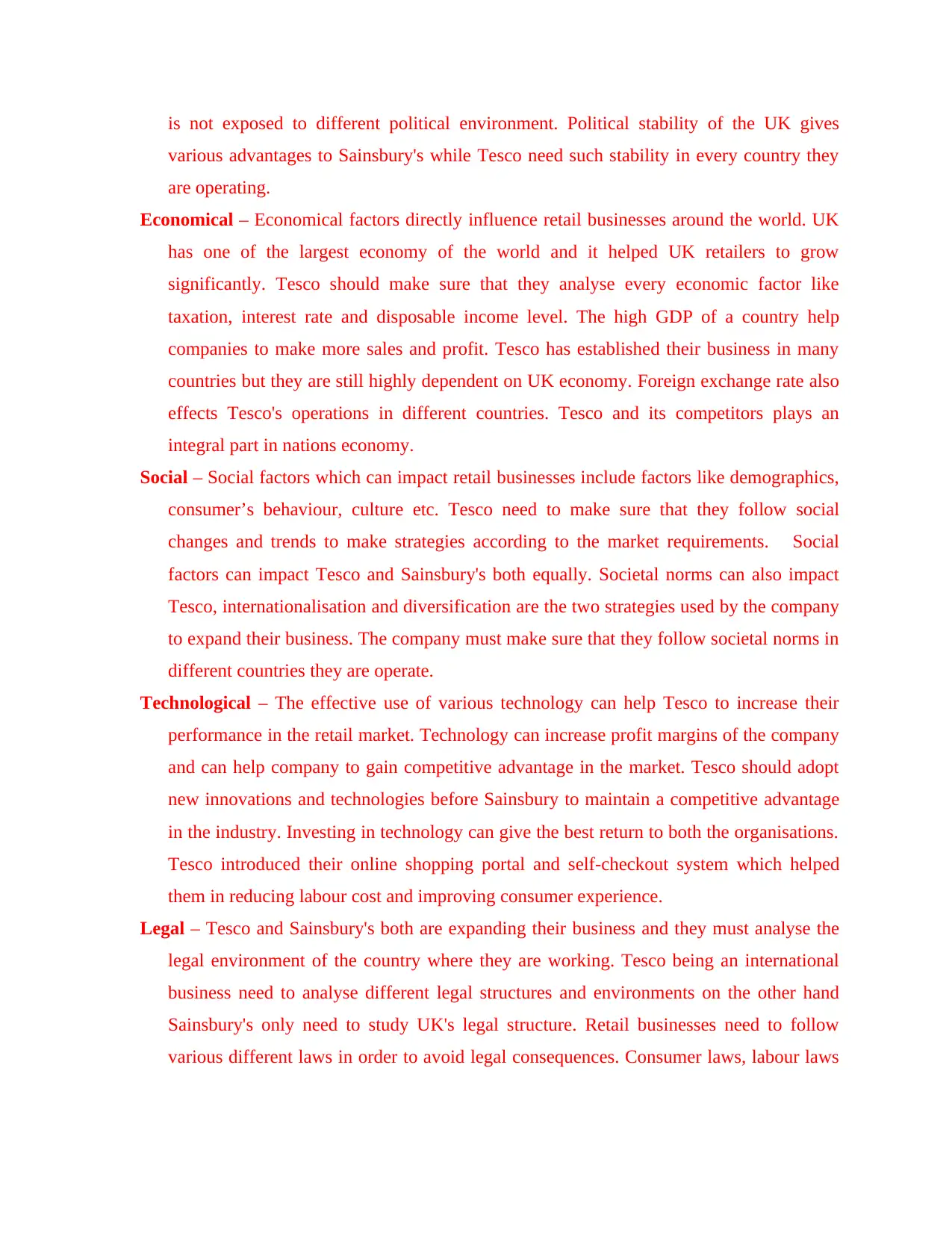
is not exposed to different political environment. Political stability of the UK gives
various advantages to Sainsbury's while Tesco need such stability in every country they
are operating.
Economical – Economical factors directly influence retail businesses around the world. UK
has one of the largest economy of the world and it helped UK retailers to grow
significantly. Tesco should make sure that they analyse every economic factor like
taxation, interest rate and disposable income level. The high GDP of a country help
companies to make more sales and profit. Tesco has established their business in many
countries but they are still highly dependent on UK economy. Foreign exchange rate also
effects Tesco's operations in different countries. Tesco and its competitors plays an
integral part in nations economy.
Social – Social factors which can impact retail businesses include factors like demographics,
consumer’s behaviour, culture etc. Tesco need to make sure that they follow social
changes and trends to make strategies according to the market requirements. Social
factors can impact Tesco and Sainsbury's both equally. Societal norms can also impact
Tesco, internationalisation and diversification are the two strategies used by the company
to expand their business. The company must make sure that they follow societal norms in
different countries they are operate.
Technological – The effective use of various technology can help Tesco to increase their
performance in the retail market. Technology can increase profit margins of the company
and can help company to gain competitive advantage in the market. Tesco should adopt
new innovations and technologies before Sainsbury to maintain a competitive advantage
in the industry. Investing in technology can give the best return to both the organisations.
Tesco introduced their online shopping portal and self-checkout system which helped
them in reducing labour cost and improving consumer experience.
Legal – Tesco and Sainsbury's both are expanding their business and they must analyse the
legal environment of the country where they are working. Tesco being an international
business need to analyse different legal structures and environments on the other hand
Sainsbury's only need to study UK's legal structure. Retail businesses need to follow
various different laws in order to avoid legal consequences. Consumer laws, labour laws
various advantages to Sainsbury's while Tesco need such stability in every country they
are operating.
Economical – Economical factors directly influence retail businesses around the world. UK
has one of the largest economy of the world and it helped UK retailers to grow
significantly. Tesco should make sure that they analyse every economic factor like
taxation, interest rate and disposable income level. The high GDP of a country help
companies to make more sales and profit. Tesco has established their business in many
countries but they are still highly dependent on UK economy. Foreign exchange rate also
effects Tesco's operations in different countries. Tesco and its competitors plays an
integral part in nations economy.
Social – Social factors which can impact retail businesses include factors like demographics,
consumer’s behaviour, culture etc. Tesco need to make sure that they follow social
changes and trends to make strategies according to the market requirements. Social
factors can impact Tesco and Sainsbury's both equally. Societal norms can also impact
Tesco, internationalisation and diversification are the two strategies used by the company
to expand their business. The company must make sure that they follow societal norms in
different countries they are operate.
Technological – The effective use of various technology can help Tesco to increase their
performance in the retail market. Technology can increase profit margins of the company
and can help company to gain competitive advantage in the market. Tesco should adopt
new innovations and technologies before Sainsbury to maintain a competitive advantage
in the industry. Investing in technology can give the best return to both the organisations.
Tesco introduced their online shopping portal and self-checkout system which helped
them in reducing labour cost and improving consumer experience.
Legal – Tesco and Sainsbury's both are expanding their business and they must analyse the
legal environment of the country where they are working. Tesco being an international
business need to analyse different legal structures and environments on the other hand
Sainsbury's only need to study UK's legal structure. Retail businesses need to follow
various different laws in order to avoid legal consequences. Consumer laws, labour laws
⊘ This is a preview!⊘
Do you want full access?
Subscribe today to unlock all pages.

Trusted by 1+ million students worldwide
1 out of 18
Related Documents
Your All-in-One AI-Powered Toolkit for Academic Success.
+13062052269
info@desklib.com
Available 24*7 on WhatsApp / Email
![[object Object]](/_next/static/media/star-bottom.7253800d.svg)
Unlock your academic potential
Copyright © 2020–2025 A2Z Services. All Rights Reserved. Developed and managed by ZUCOL.




